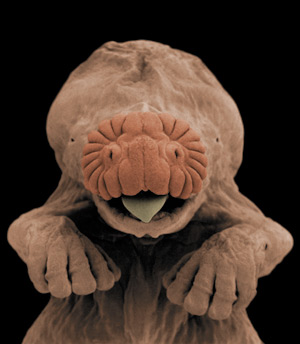Reproduction and Life History
 The reproduction habits of Condylura cristata is not
well known amongst scientists; this is due to this animal living,
breeding and raising its young in underground tunnels (Saunders
1988). That being said, there is some insight into the way that this
species breeds. The star-nosed mole is monogamous; male moles only
pick one female to mate with during the mating season (Eadie and
Hamilton 1956). Though little is known about how Condylura
cristata actually finds a partner, it is known that the male
and female pair up during the fall and stay together through the
winter and into the mating season in April (Baker 1983).
The reproduction habits of Condylura cristata is not
well known amongst scientists; this is due to this animal living,
breeding and raising its young in underground tunnels (Saunders
1988). That being said, there is some insight into the way that this
species breeds. The star-nosed mole is monogamous; male moles only
pick one female to mate with during the mating season (Eadie and
Hamilton 1956). Though little is known about how Condylura
cristata actually finds a partner, it is known that the male
and female pair up during the fall and stay together through the
winter and into the mating season in April (Baker 1983).
The star-nosed mole begins mating during the middle of March and
into April. With a gestation period of about 45 days, the new moles
are born between May and the beginning of July (Baker 1983).
Condylura cristata normally gives birth to one litter of
offspring during the year, but if the first attempt is unsuccessful
and the mating season isn’t over the pair may mate again (Eadie and
Hamilton 1956). The litter produced will normally range from two to
seven baby moles, with an average of five. When the offspring are
born, they weigh about one and a half grams and are approximately 49
mm long (Saunders 1988). The offspring are born blind and hairless
with the feelers on its nose folded up in a protective film back
towards the eyes (Baker 1983). After two weeks the star unwraps and
begins to function and the eyes open for the first time. The
offspring are then weaned and forced out of the den around the third
week (Saunders 1988). The moles become fully independent and leave
their parents after about a month. At 10 months they meet sexual
maturity and can breed during the new mating season (Baker 1983).
breed during the new mating season (Baker 1983).
Like reproduction habits, little is known about the lifespan of Condylura cristata. It is speculated that they live up to three or four years. This conclusion is based on the female mole only produceing one litter per year; they must live long enough to produce a sufficient number of offspring to sustain their population (Kurta 1995). They have been known to live up to two years in captivity (Baker 1983).
